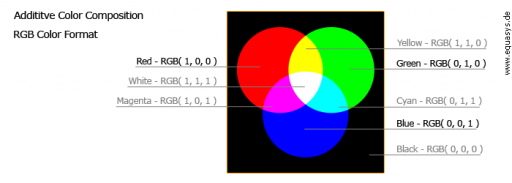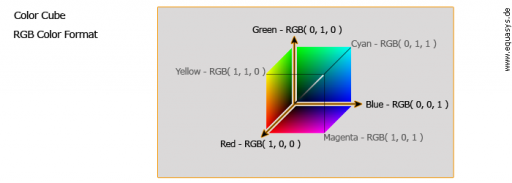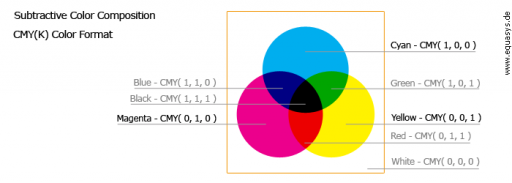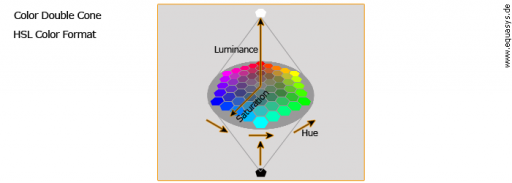Color Formats
Several popular color formats are used for image and video processing. The sections below gives an explanation of the following color formats and their usage:
- RGB Color Format
- CMY(K) Color Format
- HSL Color Format
- YUV Color Format
- YCbCr Color Format
- YPbPr Color Format
See also the Color Conversion page to get additional information about converting a color value from one color format into another color format.
RGB Color Format
The RGB color format is based on the three color components red (R), green (G) and blue (B). The RGB color model describes a color space with additive color composition as it is used in CRT or LCD monitors. Thus, the RGB color format is very popular in computer graphics and image processing.
Each color component corresponds to a certain wavelength within the spectrum of colors: red 700 nm, green 546 nm and blue 436 nm. The three color components can be seen as three linear independent vectors, describing a three dimensional color space or a color cube. The origin of the color cube represents black color with RGB( 0, 0, 0 ) and the end of the cubes’ diagonal represents white color with RGB( 1, 1, 1 ). The diagonal itself covers all gray values from black to white.
Ideally, each color component is represented by a floating point value in the range from 0 to 1. Within computer graphics or image processing applications, each color component is typically represented by 8 bits. Thus, a color value needs 24 bits to define a single color out of 16 million possible colors. For higher color accuracy 10 bits (or even 12 bits) are used for each color component.
The following image sequence shows a colored image split into its three color components red, green and blue.
CMY(K) Color Format
The CMY(K) color model describes a color space with subtractive color composition as it is used for the color printing process, e.g. used by ink or laser printers. Each color is described by the color components cyan (C), magenta (M) and yellow (Y). The additional component black (K) is used for better gray and black reproduction.
The combination of two colors from CMY color model result in a base color of the RGB color model:
- Cyan + Yellow = Green
- Cyan + Magenta = Blue
- Yellow + Magenta = Red
Correspondingly, the combination of two RGB base colors result in a CMY base color:
- Red + Blue = Magenta
- Red + Green = Yellow
- Blue + Green = Cyan
The following image illustrates the image composition by using the three color components cyan, magenta and yellow.
HSL Color Format
The HSL color model describes a color by using the three color components hue (H), saturation (S) and luminance (L). This color format is very popular for designing and editing (e.g. within graphics design tools) because it gives the user a good impression about the resulting color for a certain color value: Hue defines the pure color tone out of the color spectrum, saturation defines the mixture of the color tone with gray and finally luminance defines the lightness of the resulting color.
The HSL color model can be seen as a double-cone. The angle around the central axis represents the hue, the distance to the axis represents the saturation and position along the central axis represents the luminance.
YUV Color Format
The YUV color format describes a color by using the color components luminance and chrominance. The luminance component (Y) represents the brightness information of a color, the chrominance components (U and V) contain the color differences.
The YUV color format was developed for analog TV transmissions to provide compatibility between black-and-white television and color television: The luminance component is sufficient for black-and-white TV sets, whereas color TV sets need the additional chrominance information.
Another advantage of the YUV color format is based on the characteristics of the human visual perception: Since the human eye is much more sensitive for brightness information compared to color information, the chrominance information can be reduced within video streams without loosing significant quality. This method is called chroma-subsampling.
The term YUV can be seen as a representative for all luminance / chrominance color formats, without defining exactly the coefficients for color conversion.
Historically, the YUV color format is used to describe the color format of analog PAL and analog NTSC video equipment.
Today, the term YUV is often misused instead of YCbCr to describe the color format of digital video or images.
For component digital video the YCbCr color format is used, for component analog video the YPbPr color format is used.
The following image illustrates the image composition by using the color components luminance and chrominance.
YCbCr Color Format
The YCbCr color format is similar to the YUV color format and consists of a luminance component (Y) and two chrominance components (Cb and Cr). The term YCbCr is often confused with YUV, which is used only for analog PAL and analog NTSC video. In contrast to YUV, YCbCr is used in the context of digital image and video processing, especially, for JPEG images and MPEG video encoding.
Both color formats, YCbCr and YUV, describe a color by using luminance and chrominance, however, the coefficients for color conversion from and to RGB color format are different. For details see the color conversion page.YPbPr Color Format
Finally, the YPbPr color format is also based on one luminance component (Y) and two chrominance components (Pb and Pr) and similar to YUV or YCbCr…
YPbPr is used only for component analog video, e.g. for analog video signals from a digital YCbCr encoded video.
Again, the coefficients for color conversion from and to RGB ar different. Please see the color conversion page for more details.
Describing the most important color formats for image and video processing, like RGB, CMY(K), HSL, YUV, YCbCr and YPbPr.






